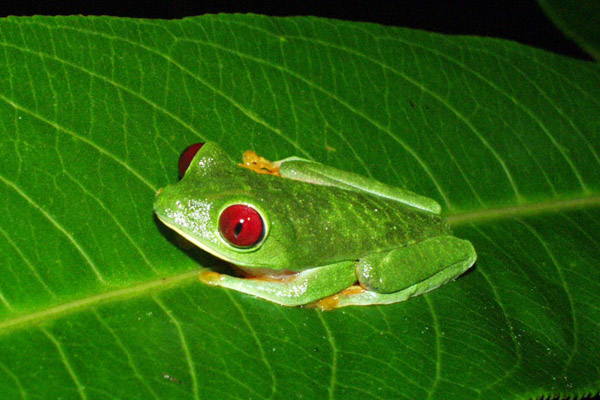Research and Analysis network for Neotropical Amphibians (RANA)Robert Stallard: Telephone: +1-303-541-3022; FAX: +1-303-447-2505 |  |
Research and Analysis network for Neotropical Amphibians (RANA)
Robert Stallard: Telephone: +1-303-541-3022; FAX: +1-303-447-2505
e-mail: stallard@colorado.edu
(7) The Neotropical amphibian die-off: Research and Analysis network for Neotropical Amphibians (RANA): As part of work in the USGS WEBB program I examined government archives to see whether data in these archives provided guidance regarding the ongoing extinction of frogs in Puerto Rico.
The past three decades have seen major declines in populations of several species of amphibians at high elevations in eastern Puerto Rico, a region unique for the humid tropics in the degree of environmental monitoring that has taken place through the efforts of U.S. government agencies. I examined changes in environmental conditions using time-series data sets that extend back at least into the 1980s, a period when frog populations were declining. The data include forest cover, annual-mean minimum and maximum daily temperature, annual rainfall, rain and stream chemistry, and atmospheric-dust transport. I examined satellite imagery and air-chemistry samples from a single NASA aircraft flight across the Caribbean, showing patches of pollutants, described as thin sheets or lenses, in the lower troposphere. The main source of these pollutants appears to be fires from land clearing and deforestation, primarily in Africa. Some pollutant concentrations were quite high and, in the case of ozone, approached health limits set for urban air. Urban pollution impinging on Puerto Rico, dust generation from Africa (potential soil pathogens), and tropical forest burning (gaseous pollutants) have all increased during the last three decades, overlapping the timing of amphibian declines in eastern Puerto Rico. None of the data sets pointed directly to changes so extreme that they might be considered a direct lethal cause of amphibian declines in Puerto Rico. More experimental research is required to link any of these environmental factors to this problem.
In 2001, a group of interested researchers coordinated by Dr. Karen Lips and Dr. Bruce Young prepared a proposal to the National Science Foundation to establish a research network to study this die-off: RANA (The Research and Analysis Network for Neotropical Amphibians).
Scientific Basis: Recent research has documented dramatic population declines and extinctions of frogs, toads, and salamanders in many parts of the New World tropics, a pattern seen elsewhere in the world. Although many excellent efforts are underway to explain these events, the pace of discovery will increase if scientists from different disciplines and different regions share a common research agenda. The Research and Analysis network for Neotropical Amphibians (RANA) is a means to achieve this common agenda. The seeds of this network were formed during a series of workshops on amphibian population declines held in November, 1999, in Mexico, Panama, and Ecuador with participation from the US and 11 Latin American countries. In December, 2001, the US National Science Foundation recommended five years of funding for the research coordination activities of RANA. RANA aims to fill some of the needs identified during the exploratory workshops.
Mission: The mission of RANA is to promote understanding about amphibian population declines through collaborative research in the Neotropics.
Objectives: To achieve its mission, RANA will
- Coordinate research on the causes of amphibian population declines in the neotropics.
- Combine comparable data collected at multiple sites by different research teams to significantly increase the generality and power of tests of competing hypotheses.
- Catalyze scientists to undertake surveys and inventories in key understudied geographical areas to provide a comprehensive picture of where declines have and have not occurred.
- Develop and disseminate a database on the current status and distribution of populations of all species of neotropical amphibians.
- Synthesize and disseminate information related to amphibian population declines.
Guiding Principles.--RANA will achieve its objectives if its members strive to:
- Work in an open and collaborative fashion
- Respect the ideas and intellectual property of others
- Fulfill commitments to other members in a timely fashion
- Disseminate research results rapidly
- Create an active network governed in a transparent fashion
Recent Research Efforts (to find out more, click on effort):
- Robert Stallard Home Page.
- Global-scale process research involving biogeochemistry and geomorphology with a focus on terrestrial sedimentation and the carbon cycle.
- Luquillo USGS Water, Energy, and Biogeochemical Budget (WEBB) Project in eastern Puerto Rico and parallel work in Panama.
- Biogeochemical implications of event-type processes at the hillslope to small-watershed scale, focusing on fire-flood sequences and landslides.
- Biogeochemical implications of glacial erosion.
- The life cycle of the giant Amazon water lily.
- Intercomparison of soils, nutrients, and plants in forest-dynamics research plots of the global tropics.
Return to: http://spot.Colorado.EDU/~stallard/
This Home Page
University of Colorado.
US Geological Survey